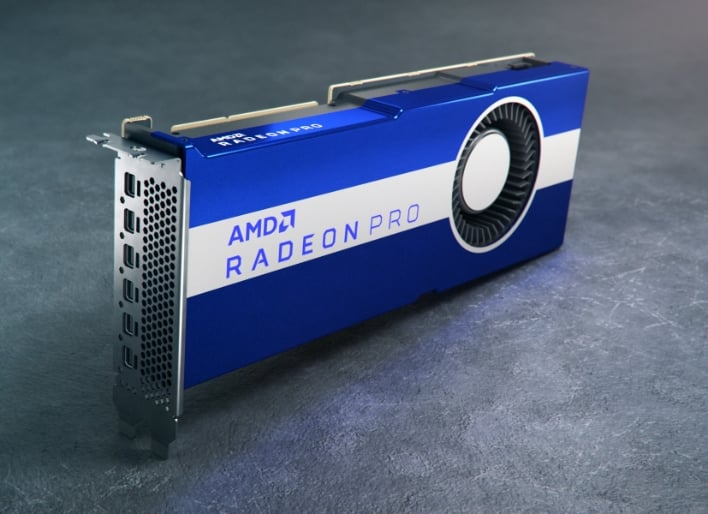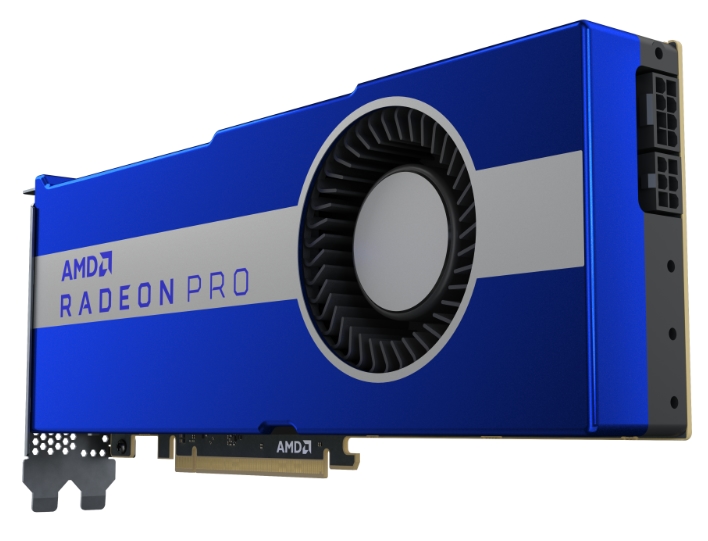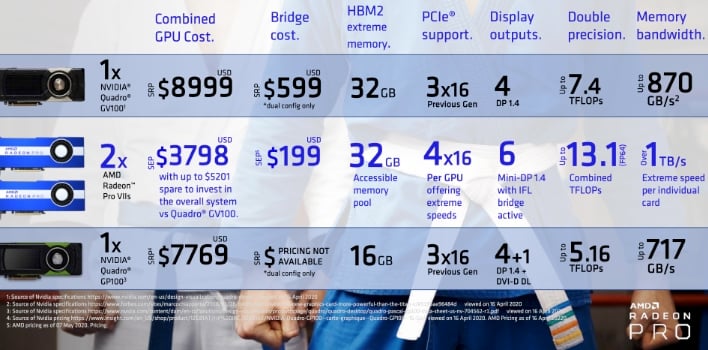AMD Radeon Pro VII PCIe 4.0 Workstation Card Sizzles With 13.1 TFLOPs Compute, 16GB HBM2

The Radeon Pro VII (Vega 20) will in effect serve as a replacement for the existing Radeon Pro WX 9100, which is based on Vega 10. The Radeon Pro VII features a total of 3840 stream processors, 16GB of HBM2 with ECC (2Gbps, 4096-bit interface, 1TB/sec bandwidth), PCIe 4.0 interface, and two Infinity Fabric links (for GPU-to-GPU communication and multi-GPU setups). With a GPU clock speed of around 1.7GHz, we’re looking at single precision performance of 13.1 TFLOPs and double precision performance of 6.5 TFLOPs. That latter figure dwarfs the 3.5 TFLOP and 779 GLFOP double precision performance of the Radeon VII and the outgoing Radeon Pro WX 9100.

The Radeon Pro VII seems to be configured most similarly to the Radeon Pro Vega II that launched with the all-new Mac Pro last year. However, that GPU has slightly higher single precision performance of 14.1 TFLOPs and 32GB of HBM2 memory. The Mac Pro also has access to the Radeon Pro Vega II Duo (which slaps two GPUs on a single board); and you can put up to two of those in a system.
AMD is aiming the Radeon Pro VII at professionals in video broadcasting, engineers, and data scientists. “Today’s professionals are challenged to meet high pressure deadlines under increasingly tight budgets while aiming to deliver world-class results,” said Scott Herkelman, corporate VP and GM for AMD’s Graphics Business Unit. “[Radeon Pro VII] provides innovative, high-performance technologies that allow users to easily manage larger, more complex simulations, create and manage exceptionally high-resolution digital media and digital signage content, and develop advanced HPC applications to drive new waves of scientific discovery on large scale supercomputer deployments.”
AMD supports the Radeon Pro VII with its Radeon Pro Software for Enterprise driver software, which the company says has delivered a 14 percent year-over-year performance boost for existing hardware. Likewise, updated Radeon ProRender software has been released, along with a new beta of the ProRender 2.0 SDK.
“Radeon ProRender 2.0 also lets developers boost their applications’ rendering performance with improved CPU + GPU rendering,” AMD explains. “For example, when tested with our internal render test with the just announced the AMD Radeon Pro VII plus the AMD Ryzen Threadripper 3990X working together, render times were up to 47 percent faster.”
Other updates include the release of AMD Radeon Rays 4.0, a new ProRender Plug-in for Unreal Engine 4, and plugin-in support for Blender 2.83.
AMD says that the Radeon Pro VII will be available next month priced at $1,899, and will be installed in systems from its “leading OEM partners”.


